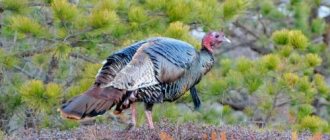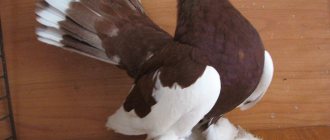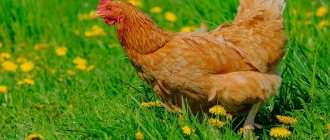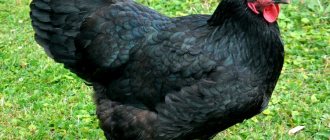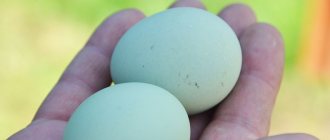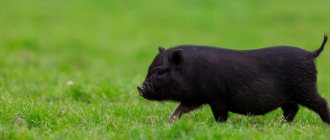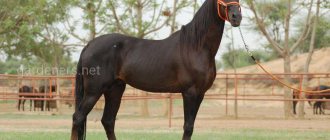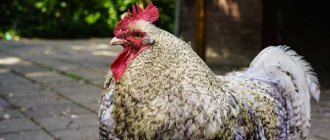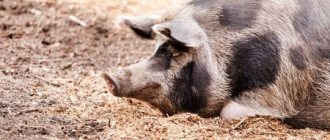Crosses are the result of crossing different breeds, so they combine only the best qualities of the directions used for selection. With proper care, in just a couple of months, the chicken gains significant weight, and its meat turns out juicy, tender, and tasty. The main disadvantage of broilers is that they do not pass on all the positive qualities by inheritance. Read more about the breeding of breeds, their characteristics, the main directions of cultivation and varieties of crosses popular among Russian farmers.
Chicken crosses: difference from breeds
The process of obtaining crosses is called crossbreeding. The most effective representatives of the breed are selected for it - a rooster and a laying hen. Individuals obtained from such information are often also crossed with representatives of another breed or with the same cross. In the latter case, broilers are obtained - more on that below.
There is a fundamental difference between crossbreeding and ordinary interbreeding of birds. When traditionally crossing two breeds, the main goal is to improve one of them or create a new species.
But individuals bred as a result of crossbreeding are not used for further breeding. In this case, only the first generation of crosses is valuable. The poultry population is also replenished through the breeding of maternal breeds, rather than the resulting hybrids. This is how breeds and crosses (hybrids) of chickens differ from each other.
Crosses are used utilitarianly. There is no point in breeding offspring from them, since they will be unproductive.
Most hybrids are bred from the White Leghorn breed. Be sure to read the article “About Leghorn chickens: characteristics of the breed.”
What is a line
Within each chicken breed, breeders develop several lines with better qualities than the rest of the breed. Over time, the lines degenerate and the bird loses its productivity. To prevent this from happening, the lines are periodically crossed with each other, which makes it possible to preserve or restore the useful qualities of the animal.
Efficiency of chicken crosses (egg direction)
Statistics
Egg-crossed chickens are more productive than their purebred counterparts. If hybrids produce more than 300 eggs per year, then purebred laying hens produce about 200 eggs. Moreover, crosses, unlike purebred chickens, actively lay eggs only in the first year of life.
Are hybrids suitable for private backyards?
Crosses are more in demand at poultry farms, where there are specialists in breeding highly effective hybrids, and it is easier to create the necessary conditions for the birds.
At the same time, nothing prevents farmers from purchasing young crosses for their subsidiary farms. The main difficulty here is creating the necessary conditions for the birds and the fact that the breeder will have to annually update the stock by buying new cross-breed chickens.
That is why small farmsteads most often use purebred laying hens, which are much less hassle and are capable of producing eggs over a long period of time.
Differences between laying hybrids
Egg-cross chickens lay brown or white eggs. The shade of the shell depends on the color of the laying hen's plumage. Brown crosses are slightly inferior in egg production to their white relatives. But at the same time they are larger - when slaughtered they produce more meat. They have more eggs and it is easier to care for such chickens, as they are calmer and unpretentious in keeping.
Unlike white hybrids, they have different colors for males and females, making it easier to sort the chickens. A small disadvantage of motley hens is that they consume more feed than white ones. Accordingly, the cost of their testicles is slightly higher.
White and brown eggs
The color of a chicken egg shell depends on the breed of laying hen, and, according to experts, does not in any way affect the taste of the eggs or the amount of nutrients they contain.
Experts call the opinion that brown shells are stronger than white shells a myth. The thickness of the eggshell depends on the feed and the age of the bird, not the color. The main difference between eggs is that dark ones are larger than white ones.
Noble beauties of the Sussexes
Individuals of this breed are distinguished by their elegant appearance.
Chickens with a characteristic pattern on the neck and tail attract attention with their grace. There are many color options for individuals: Colombian, fawn, white, lavender, porcelain, brown, etc.
Light Columbia Sussex
The most popular in Europe and Russia is Colombian. Representatives of this species are white with a dark “necklace” on the neck. The ends of the flight and tail feathers are also painted black.
Sussexes in the poultry house - photo
The main characteristics of the breed are as follows:
- weight – 2.4-2.7 kg (females), 3-4 kg (males);
- egg weight – 56-58 g;
- beginning of oviposition – 5th month of life;
- productivity – 170-190 pcs.
The Sussex breed is very precocious: with proper care, young animals gain slaughter weight at 100-120 days of life. The breed's egg production depends on the time of year: in winter, productivity drops significantly, so on large farms chickens are often slaughtered with the onset of cold weather.
Sussex chickens
Content Rules
From area to inventory
Let's consider the general principles of keeping egg crosses on farms.
Chicken coop area: purchase birds at the rate of 1 square. m for 4 individuals.
Bedding: Cover the floor with a 5 cm layer of sawdust or hay. As it gets dirty, first add a second or third layer of flooring, and then replace it with a clean one.
Drinkers and feeders: keep in mind that the edges of these devices should be at the level of the bird's back so that the chicken is comfortable.
Perch: beams with a diameter of 30-40 mm are suitable for these purposes. Place them at a height of about 60 cm, and choose a length such that all the birds can comfortably fit on them.
Nests: one structure is designed for three chickens, its depth should not exceed 30 cm. It is better to arrange the nest in the darkest place of the chicken coop. Be sure to place a rubber mat on the bottom to prevent the eggs laid by the chickens from breaking.
Walking and equipping the chicken coop
Walking: egg crosses are more active than meat ones. Make openings from the chicken coop to the walking area and be sure to cover it with a net. Place a container of sand there so that the birds can “take baths” and clean their feathers.
Heating: chickens tolerate temperature changes well, but if the thermometer drops below 10 degrees, then the chicken coop needs to be heated.
Humidity: ideal 60-70%.
Ventilation: the air in the room should not be musty.
Poultry house lighting: A chicken coop needs windows to let in daylight. In winter, install additional lighting. The optimal length of daylight hours is from 12 to 14 hours.
Egg crosses can also be kept in cages. In this situation, it is necessary to increase the density and purchase young animals at the rate of 14 heads per 1 sq. m area.
"Competitor-2"
A two-line cross, created by breed scientists in 1999. by crossing Cornish with Plymouth Rocks. The hybrid obtained as a result of selection made it possible to significantly reduce maintenance costs compared to the original lines (more than 12%). At the same time, the average individual is not inferior in weight to a four-line cross.
These chickens are characterized by increased productivity and excellent adaptability to various types of housing in farms of various sizes. At one and a half months of age, the weight of broilers exceeds 2.6 kg. The rate of feed consumption for live weight gain in the amount of 1 kg is up to 2 kg.
According to external features, “Competitor-2” has a medium-sized head with a leaf-shaped crest. The back is wide and elongated. The chest is deep set and wide. The bones are strong. The limbs are widely spaced, the muscles are developed. The plumage is white and dense.
Feeding hybrid laying hens
Birds must be given: meat and bone meal, cottage cheese (low-fat), fish, supplements containing sulfur, vitamins and minerals. It is better to add these ingredients to porridge or mash.
To strengthen the shells of eggs, be sure to feed the birds with chalk, shell and limestone. These additives can simply be scattered on the area where laying hens graze.
In the diet of birds, in addition to grain mixtures (it is better to purchase factory-made ones), juicy greens must be present. Particularly useful are nettle (young) and dandelion (leaves).
Table: diet of egg crosses at different times of the year.
Mini meat chickens: features
Mini-meat chickens are also often found on farms. They first appeared in Russia. The breed has gained popularity not only among domestic poultry farmers, but also in Europe. There are many advantages of mini chickens:
- their meat is very tasty and soft, and the birds quickly gain muscle mass;
- eat any food, absorbing all the nutrients from it well;
- Which breed has the largest eggs? Oddly enough, the mini-meat chicken lays large eggs, even larger than other representatives of the meat category;
- The birds are calm and quiet and do not tear up the ground.
Mini chickens also have a number of distinctive features:
- they have short legs and low body weight;
- the comb is small, leaf-shaped. Due to this, it does not freeze even at very low temperatures;
- the plumage is dense and hard. May be white, fawn or red.
Such chickens grow well, but chickens love warmth. The air temperature must be at least 35 degrees. In this case, almost all individuals can survive. With each subsequent week, the temperature must be reduced by 2 degrees.
The average weight of chickens is 2.7 kg, and that of roosters is 3 kg. Bird meat is very tasty, and due to the fact that the fat is distributed between the muscles, it is also juicy. They have good egg production rates (up to 179 eggs per year weighing 60 grams).
Popular chicken hybrids
White egg crosses
Loman White: these chickens eat only 100 g of feed per day. Moreover, their weight is 1.7 kg, and their annual productivity is 350 eggs. At the same time, the testicles are one of the largest - 64 g. Another plus is that egg production does not depend on the time of year.
Launch N-23: the bird weighs 2 kg. The daily feed requirement is 110 g, the annual egg production is from 280 to 300 pieces. The egg of this cross weighs 62 g.
Hisex White: eats 100 g of feed mixture per day and weighs 1.8 kg. and lays 300 eggs per year. Has excellent immunity. These birds are even immune to fungal diseases and helminths.
Hy-Line W36: these are calm, friendly birds. One individual weighs about 2 kg and produces 290 eggs in 12 months. She needs 110 g of food per day.
Brown egg crosses
Borki-color: this species is distinguished by its large size - 2.1 kg, but its daily feed intake is 115 g. This chicken produces 260 eggs per year, with an average weight of 60 g. Hybrids are considered non-capricious and very tenacious.
Progress: distinguished by a record weight for egg breeds, reaching up to 3 kg. However, his need for food is corresponding - 155 g per day. Egg production for 12 months – 260 pcs.
High Line Brown: poultry farmers love this species for its “iron” health and high egg production (330 pcs./year). The average carcass weight is 1.6-1.7 kg. He needs 110 g of food per day.
High Line Silver Brown: weight and feed consumption are the same as the previous subspecies of this cross, but egg production is higher - up to 350 pcs. in a year.
Crosses of egg-laying chickens are also popular: Loman Brown, Hisex Brown, Tetra-SL.
To replenish the population of crosses, it is necessary to maintain a herd of representatives of the parent breeds, since the offspring of hybrids are characterized by low productivity, and there is no point in breeding them.
Chicken breeding business
You can raise chickens at home not only to meet your own needs, but also to make money from it. First of all, you should analyze the pros and cons. And only then open your own small home business. Breeding chickens in the initial stages only requires a lot of desire and start-up capital.
First, you should think about what crosses of chickens will be raised. In parallel with choosing a breed, you should start preparing all the necessary documents for legalizing your business. If you develop a business plan, you can receive a subsidy for farming.
The next step is to choose a place where you plan to keep the birds. If you plan to make a small profit, then you can organize a mini-farm on your personal yard, if its area is large enough. In other cases, you can rent a room or a plot of land.
Then the purchase of young stock is made and sales of the finished product are sought. When calculating your budget, you should take into account the costs of medicines, feed, and veterinary services. It is not profitable to constantly purchase young animals; it is much more profitable to hatch chickens from your own eggs. To do this, you will need to think about a place where young animals of different ages will be kept, and purchase an incubator.
If you follow the technologies for raising and feeding chickens, you can get a net profit of 50 thousand rubles from 50 chickens per year. If possible, it can be increased by selling not only eggs, but also young animals.
Raising chickens is an interesting and easy task. You can keep these birds not only for your own needs, but also sell their products at the market, in cafes, restaurants, and shops.
Meat crosses (broiler)
Separating similar concepts
As was said at the beginning of the article, broilers and crosses are different concepts. However, they have similar features. Both were bred for meat, but broilers are often larger. What is described in the article “About broiler chickens: what they are and which ones are better.”
And yet, crosses bred for meat products are called broilers. Some of them participated in the breeding of new types of broilers. It is these varieties that can be called broiler crosses.
When creating this type of bird, the selection was based on two factors: the rate of biomass growth and the cost of feeding the birds. As a result, several meat crosses were bred.
In a couple of months they gain full weight - about 2.5 kg. At the same time, feed consumption averages 1.75 kg of mixture per 1 kilogram of chicken. The meat yield per chicken reaches 230 kg.
Creating optimal conditions
Requirements for a poultry house for meat cross chickens:
- Birds do not need a spacious coop. The optimal ratio is 1 sq. m of floor for 10 heads. There is no need for a walking area.
- The length of the optimal daylight hours for adult birds is 12-14 hours.
- Ventilation and heating are required. Meat crosses feel comfortable at temperatures from 5 to 23 degrees.
- Chickens do not need nests or roosts, but they do need good flooring (deep litter).
- Humidity should be 60–70%.
If desired, meat crosses can be kept in cages. In Russia, this method is more common than floor breeding of such birds. In this situation, you will save space in the poultry house, simplify cleaning and eliminate the contact of birds with other living creatures.
Feeding
Meat cross chickens are often fattened according to a four-stage scheme.
Table: feeding by age.
Do not feed birds beets, fermented and sour foods, soaked baked goods, meat, cheese, sausage, products with cocoa, or full-fat milk. Spoiled fish is very dangerous for these chickens.
The best chickens for home
Many novice farmers are interested in what the best chickens for home and chicken breeds are, and how they differ from the rest. You need to know this in order to decide on the type to grow.
Bengal
This meat and egg breed of Bengal domestic chickens can be distinguished by its appearance. Birds have plumage with a strong upward bend of the shaft. Ornamental chickens are considered good brood hens and consume little feed. The Indian variety of females weighs 2-2.5 kg, roosters - 2.5-3 kg. Chickens lay eggs from six months; approximately up to 165 eggs are released per year, weighing 57 grams. and brown color.
There is also a dwarf classification of animals; they weigh from 500 grams. up to 900 gr., and eggs – 35 gr. Such birds have a high survival rate. The picture shows that the bird truly has curly plumage.
Plymouthrocks
This is a versatile breed of Plymouth rock laying hens, which is excellent for producing a quality meat product. Such specimens were brought to Russia in 1911 and since then they have been in great demand among farmers.
A distinctive feature of the variety is the yellowish coloring of the legs and beak, large orange pupils. As for color, birds come in the following shades:
- pure white;
- pale yellow;
- deep black;
- striped, mostly gray.
Up to 195 large eggs with a light color and a weight of 60 grams are hatched per year. Hens weigh 3.5-4 kg, roosters up to 5 kg.
Redbrough
The best laying hens of the Redbro breed belong to the meat-egg class and are a hybrid of traditional broilers with poultry. This variety is characterized by rapid weight gain. By 6 months the animal will weigh 6 kg.
Chickens begin to lay eggs at five months; in the first year they are capable of producing 170 eggs, but each subsequent year the number increases to 300.
The Redbro variety and its eggs are highly prized in cooking. Therefore, birds are raised primarily to supply restaurants and cafes with the product. It is quite difficult to purchase chickens; on the market they can be passed off as completely different species that are less valuable.
Brekel
This breed of Brekel chicken was bred in Belgium to produce birds with a high degree of egg production. More than 260 white eggs weighing 60 grams are produced per year. Animals can have two colors - silver and golden. They are characterized by increased activity and volatility, so for this breed of chickens from the photo you need an aviary with a high fence of more than 2.5 m and a mesh covering.
The weight of a rooster reaches 3 kg, of a female – 2.7 kg. They can be kept with other types of birds, since the Brekel has a calm character and does not conflict.
Vorwerk
The best chickens with the name Vorwerk are considered a universal variety that appeared 100 years ago thanks to German breeders. The whole body of the bird is covered with chestnut-colored feathers, there is a clear dividing stripe on the neck, the head and part of the neck of the bird are black. Chicks are born almost entirely dark gray or black in color.
In the first three years, hens produce 170 eggs, but in subsequent years the number drops to 130 eggs. Therefore, when the “productivity” decreases, the laying hens are updated.
Cornish - description of giant chickens
Pedigree best giant chickens with photographs and names can often be found at exhibitions. Cornish is a meat variety developed in Britain more than 60 years ago. This species is considered the first broiler. By the third month, chicks weigh 3 kg, and adults more than 5.5 kg. The meat is used in the production of baby food because it is distinguished by its softness and refined taste.
In addition, hens can lay up to 125 eggs per year weighing 40 grams. and light brown shell. The Cornish is pure white, but species with blue or black edges on their feathers are sometimes found. The lazy bird is suitable for keeping in cages, since it even feeds in a sitting position.
Downy Chinese (silk)
On the Internet you can often find photos with descriptions and videos of Chinese fluffy chickens, on whose body not the usual feathers grow, but fluff. It covers the entire surface, resulting in only the bird's beak and paws being visible.
Such species are grown to produce fluff and meat, which is considered medicinal in many nations.
The color of the bird can be very different:
- red;
- red;
- white;
- gray;
- black;
- yellow;
- combined.
But black chickens are considered the rarest, since they have a unique feature - their skin has the same color as their plumage.
Effective crosses (egg and meat)
Hybrids producing the largest number of eggs
Taking into account the costs of caring for and maintaining poultry, its resistance to disease, feed requirements, and the final cost of products (meat and eggs), experts have identified the top 3 leading crosses in both directions.
Loman Brown: not demanding in care and nutrition. They weigh on average 1.7 kg and eat 102 g of food per day. A laying hen produces from 280 to 320 eggs in 12 months. A big advantage is the affordable price of chickens.
Hisex Brown: more productive than a similar white cross. Not susceptible to low temperatures. It lays eggs all year round and produces 280-315 eggs in 12 months. Weighs 2 kg and consumes 110 g of feed per day. The eggs of these chickens are considered dietary due to their low cholesterol content.
Tetra-SL: distinguished by an impressive egg size - 65 g. The average weight of an adult is 2 kg, with a daily feed consumption of 125 g. Annual egg production is up to 310 pcs. Main advantages: “precocity” and dietary meat.
The most effective meat crosses
Shift 2: the undisputed leader in Russia. Almost one third of all chicken meat produced in our country is the carcasses of these chickens. This cross gains 2.3 kg in 42 days.
SK Rus-2: by the 42nd day of life it reaches 2.1 kg of weight. Chickens of this type account for 1/6 of the chicken produced in the country. The main disadvantage is that it is adapted for breeding only in the southern regions of Russia.
Competitor and competitor-2: they account for 1/10 of Russian-produced chicken. Cross competitor reaches a weight of 2.5 kg by 7 weeks. The weight of Competitor-2 is a little more - 2.6 kg at 42 days.
Breeds of meat birds
Among the representatives of the meat cross, the following types are distinguished:
- "Cornish". The bird weighs 3-4 kilograms. Over the course of a year, she lays up to 110 eggs weighing up to sixty grams.
- "Brahma". Average weight 4-5 kilograms. Egg production averages one hundred eggs per year weighing up to 65 grams.
- COBB-500. The peculiarity of the breed is early maturity. By the fortieth day, the weight of the chicken reaches 2.5 kilograms.
The Leghorn, Lohmann, and Hubbard breeds are often found in households.
Meat and egg crosses
The most popular universal hybrids are:
Ross-308: grows up to 2.5 kg in 2 months, annual egg production - 180 pcs. Read more about the cross in the article “Chickens Ross 308: description and characteristics.”
Broiler 61: in a month and a half they reach a weight of 2 kg. They do not require complex care, egg production is standard for a generalist.
Hybro-6: crosses reach a weight of only 1.3-1.6 kg, but are valued due to the fact that their carcasses have a pleasant yellowish tint. Egg production – 160 pcs. in year.
Cobb-500: in a month and a half it grows up to 2.5 kg, and produces the standard number of eggs for generalists. You will be interested to know “Description of the Cobb-700 broiler and its difference from the Cobb-500.”
Cross Change: This bird produces up to 150 eggs annually and gains about 2 kg in 42 days.
Broiler-M: reaches a weight of 2.5 kg, annual egg production - 150 pcs.
Be sure to read the article “What is the difference between broilers Cobb-700, Ross-308 and Ross-708.”
"Siberian"
A highly productive meat cross, bred in 1999 by employees of the Siberian Research Institute. Several crosses of domestic selection (“Broiler-6”, “Smena”) were used as a gene pool in combination with the results of foreign selection (“Euribred”, “Ross”).
The resulting hybrid is perfectly adapted to cellular maintenance under production conditions. The bird quickly adapts to unfavorable environmental factors. It is characterized by a high level of safety - 98%.
The productivity of laying hens from the parent flock is about 130 offspring. The maximum period for raising broilers is up to 50 days. Taking into account the average daily gain of 38 g, by this time they will already weigh more than 2 kg. To gain 1 kg of muscle mass, chickens need 2.1 kg of feed.
Advantages and disadvantages of crosses
Cross-breed chickens have a number of disadvantages that are not significant for poultry farms, but are extremely important for owners of small farms. First of all, this is a short period of productivity. Egg crosses lay eggs well only during the first year of life. While purebred chickens produce 200 eggs in 12 months for 3-4 years.
The second serious disadvantage is that the farmer needs to purchase new young animals every year, since it is extremely difficult to breed crosses on your own. Moreover, some crosses are not suitable for breeding in private farmsteads, as they require special housing and feeding conditions. However, there are still breeds suitable for keeping on small farms.
The advantages of cross-breed chickens seriously outweigh the disadvantages. They are much more effective than purebred relatives in terms of weight gain or egg laying volume. These birds are also distinguished by their endurance and excellent health. Crosses are not susceptible to many diseases, and the survival rate of young animals often exceeds 90%.
If you liked the article about chicken crosses, please repost and like it. Share your opinion on breeding such hybrids in the comments.
Classification
The classification includes three main types of chickens that are grown in the agricultural sector.
Egg
Egg-bearing birds are bred by crossing Island Island breeds with other breeds of laying hens. In hens of the egg production direction, the egg shells are white with a slight brownish tint. Such birds have many advantages, including resistance to high temperatures and stress. Therefore, they are suitable for growing in chicken coops, which are often hot.
Meat
People who want to get a lot of meat should raise meat chickens. On average, two kilograms of feed yield more than 1,500 grams of meat. Meat birds must be kept on the floor in special cages. This is done so that they move less and constantly gain weight. Such chickens must be raised within forty days. During this time, the weight of one bird will increase to 2-3 kilograms.
Universal
Versatile birds that can be raised for both meat and eggs are popular. In addition to versatility, the advantages of chickens include their unpretentiousness to living conditions. They can be raised in hot or cool coops.
Types and examples
Egg crosses
Most egg crosses are produced with the participation of the White Leghorn breed[11]. Famous crosses with the participation of leghorns are the Soviet and Russian “Start-1”, “Yantar-1”, “Crystal-5”, “Volzhsky-3”, “Belarus-9”, “Borki-1”, “Borki-2” and B-121[12]; foreign ISA Brown, Lohmann Brown, Tetra-SL and Hi-Line[13][14].
In industrial egg farming, chicken crosses are also divided according to the color of their eggshells into white and brown. To obtain the latter, white Leghorns are crossed with the New Hampshire and Rhode Island breeds. Black Australorp birds are also often used to create lines and crosses with colored eggshells[11]. Crosses with colored eggshells are traditionally common in England, France, Italy, the USA and Japan, as well as in the Scandinavian countries. It is noteworthy that the so-called brown crosses have better safety of young and adult birds, are more resistant to production stress, are characterized by higher productivity, have a calmer disposition, provide more opportunities for sorting by sex (autosexing)[8], and also enjoy increased consumer demand.
There are many crosses of egg poultry, but the most common in Russia is the “Rodonit” cross. It accounts for about 42% of the total egg-laying poultry population in the Russian Federation. It was created by specialists of the Sverdlovsky State Processing Plant, together with scientists from VNITIP, over a short period of time - from 1989 to 1995 as a result of selection work with lines of the Lohmann Brown cross, imported from Germany (). The bird of this cross has a high genetic productivity potential - 296 eggs per average laying hen per year, 18.9-19.2 kg of egg mass (number of eggs × average egg mass), feed costs for 10 eggs - 2.2 kg. The eggs and meat of this bird are characterized by high taste. The cross consists of two lines of Rhode Island Red chickens (paternal form), the third - Rhode Island White and the fourth - synthetic, bred on the basis of white Plymouth Rock and white Rhode Island (both lines of maternal form). A characteristic feature of this cross is the autosexity of the maternal form in terms of feathering rate, and the final hybrid - in terms of plumage color at one day of age. This means that cockerels at one day old are easy to distinguish from hens. Thus, the final hybrids of cockerels are mainly light yellow, and also yellow with a brown spot on the head, but the coloring around the eyes is light; hens are usually brown, sometimes with a lighter head or back, brown around the eyes and at the base of the head. This is of great importance for homestead owners who purchase day-old chicks to obtain food eggs, and can easily select chickens. For those wishing to start their own small parent flock of this cross and receive hatching eggs, it is useful to know that day-old chicks of the maternal form have differences in the rate of plumage growth depending on their gender. To determine the sex of a day-old chick of the parent form, take the chick in the left hand, fix the wing with the thumb and forefinger and turn it slightly, looking through the flight feathers and coverts. If the coverts are shorter than the flight feathers, then this fast-feathered chick is a hen; if the flight feathers are slightly shorter than the coverts or the same length as them, then this late-feathered chick is a cockerel[15].
Of the imported crosses that lay eggs with brown shells, Russian farms keep “Lohmann Brown”[15] and “Hisex Brown”[5][8][15][16].
“Hisex White” is a four-line cross obtained on the basis of the white Rhode Island. The bird of this cross is highly productive - egg production is 280 eggs or more with a weight of 62 g. However, this cross reacts strongly and painfully to unfavorable changes in feeding and housing conditions, so the population of this bird is 3%[15].
Meat crosses
In the 2000s, the Russian Federation again intensified work on obtaining highly productive crosses of meat chickens[17] due to growing consumer demand in the domestic market and the gradual replacement of imported meat with domestic ones. Among Russian meat crosses, the most common is “Smena 7”[18][19]. The cross "Smena 8" was created using the genetic material of two crosses - the domestic "Smena 7" and "Ross 308" of English selection[20].
Chicken coop
For a small family, having 10 birds is quite enough. You can keep ten chickens of different breeds in separate chicken coops.
Any chicken coop for 10 chickens must be warm. The minimum temperature that should be in the room is -2 degrees.
In order for chickens to lay eggs consistently, it is necessary to organize lighting in the chicken coop: provide windows and electric lamps.
Each breed has its own requirements for housing density. Broilers are kept in a room with a stocking density of no more than three chickens per square meter. Egg breeds do well at a density of four birds per square meter. When keeping chickens in winter, you can increase the stocking density to six birds. This way they can withstand the cold better.
Before you start building a chicken coop for 10 chickens, you need to choose a place where it will be located and make drawings of the structure. The height of the room should be such that a person can easily walk there without bending his head. The warm part of the chicken coop should be about 2.5 meters in area. The bird must take a walk. To do this, a canopy fenced with mesh is attached to the warm part. Its area should be about 3 square meters. m. A hole with a diameter of about 50 cm is made between the barn and the walker so that the birds can pass freely. Perches and nests are placed inside the chicken coop. Three nests are enough for ten chickens.
Crossbreeding technology
The process of creating a new bird is called crossbreeding. To implement it, representatives of two different breeds (lines) with the best productivity indicators are required. Depending on the orientation of the resulting bird, chickens and roosters of egg or meat breeds are taken. A more complex crossbreeding option is possible, when the resulting hybrid will be crossed again with a third line or cross of chickens.
Chicks from banal interbreeding are successfully used for further breeding of a new line or improving the qualities of the parent breed.
Breed selection and herd formation
When choosing egg-laying hens, the future owner must first of all decide for what purpose he is getting pets and in what mode he intends to further form a poultry flock. If your plans are solely to supply your family with fresh eggs, you can give preference to a productive breed or cross that is available for sale at a nearby farm or poultry farm. If you have a home incubator, you can purchase fertilized eggs (this will cost the least) and hatch the chickens yourself. Purchasing day-old or slightly grown chicks requires relatively large expenses, but makes it possible to avoid losses during hatching. Varieties of chickens characterized by pronounced autosex of young animals (for example, “Rhode Island”, “Tetra”, “Loman Brown”, etc.) allow you to immediately purchase hens and cockerels in the ratio necessary for the correct formation of the breed.
Autosexness (different colors of down, the presence of spots and stripes) helps determine the sex of a chicken already on the first day
Many summer residents prefer not to waste any effort at all on raising young egg-laying hens. From spring to early autumn, most poultry farms sell so-called “pulls” (young chickens about 1.5 months old) of the most popular varieties. Their purchase requires a more significant investment. But this approach, with proper care and feeding, almost completely eliminates the death of pets. A grown bird is easier to feed and maintain, and if purchased in the spring, it can begin to lay eggs at the end of summer.
An owner who intends to renew the flock in the future using his “own” chickens must be concerned not only with acquiring a sufficient number of cockerels (the optimal ratio is considered to be 1 male per 8-10 females), it is also important to take into account the ability of the chickens of the chosen breed to incubate. Many pure egg varieties by nature, or rather through the efforts of breeders, are deprived of maternal instinct in order to maintain stable productivity. To ensure their reproduction, the farm must have either a household incubator or chickens of other breeds that can act as brood hens.
Females of meat-egg breeds are considered the best brood hens.
There are several opinions regarding the mandatory presence of roosters in the herd. Some owners believe that in the absence of a male, chickens cannot lay eggs at all or lay eggs of poor quality. It is a myth. The presence of a rooster nearby does not in any way affect the productivity of laying hens or the quality of the eggs they lay. True, without a male, the eggs are unfertilized. They are not suitable for breeding offspring, but when forming a herd in the mode of purchasing new “pullets” to replace discarded ones, fertilized eggs are not required. However, this does not mean that a rooster is not needed in the herd at all. The male in the chicken coop plays the role of “organizer” and protector. With it, chickens suffer less from stress, do not quarrel, do not run away, and do not try to fly over the fence of the range.
Experienced poultry farmers claim that a maleless chicken flock sometimes produces an “informal leader.” One of the hens begins to “command” her companions and becomes too lively and aggressive. At the same time, she completely stops laying eggs. This fact also indicates that the presence of a rooster in the yard is important for the normal life of poultry.
Crosses obtained through complex hybridization are not intended for breeding at home - their complex of improved characteristics is not inherited by offspring
Some owners keep egg-laying chickens not only for edible products, but also for the purpose of purebred breeding. This type of activity requires both significant costs and serious experience. On the other hand, it can become a source of good income, since hatching eggs and chicks of rare and beautiful varieties of chickens, despite the very high cost, are extremely in demand among amateur poultry farmers.
General information
Man was familiar with chickens even before our era. Currently, there are about 180 different breeds. As for egg-laying chickens, they were bred for the purpose of producing eggs. Laying hens do not have a brooding instinct. They are small in size and you won’t be able to get a lot of meat from such a chicken. Mini chickens and eggs lay excellent eggs. All these breeds are quite active and require a large area for walking.
Regardless of which breed is chosen, egg-laying chickens have common characteristics:
- Quite light bones and low carcass weight.
- Wide and large wings, the tail has long feathers.
- Large comb and earlobes.
- High activity.
- Rapid puberty, many laying hens begin to lay eggs 25 days after birth.
- Lack of brooding instinct. Therefore, if you want to start breeding, you cannot do without an incubator.
- Quite a small amount of balanced food, especially rich in calcium and mineral supplements.
